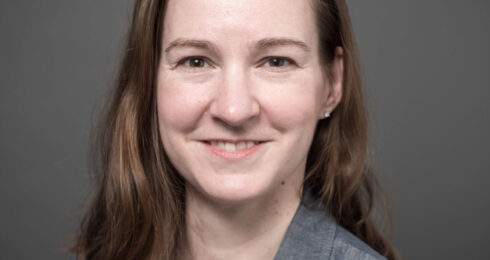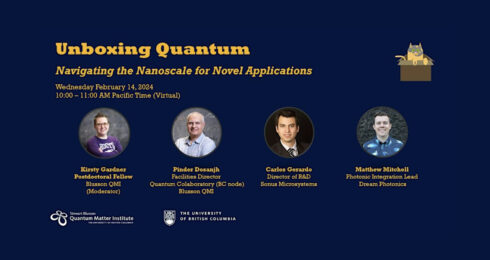At the intersection of quantum physics, theoretical chemistry and machine learning, Roman Krems is working to understand realities outside the mathematical limitations of the known world. But his approach is novel; rather than harnessing the power of artificial intelligence to wade through quantum mechanical data, he is hoping to train machines to approach physics exploration the way a human physicist would.
,
“I wake up excited every morning because in my current research, there are a lot of interesting opportunities to learn new physics, new mathematics, new computational techniques,” said Krems, a Professor in the Department of Chemistry, Faculty of Science, and Distinguished University Scholar. Krems was appointed a member of the Stewart Blusson Quantum Matter Institute (SBQMI) in June.
,
“Quantum problems are very difficult; as the complexity of quantum systems increases, you eventually hit a wall in terms of what you can achieve using conventional approaches,” explained Krems. “We’re using theoretical and machine learning models to go over (or through) the wall, to solve bigger problems than are currently feasible.”
,
Think about an electron in a complex material.
,
At the microscopic level, atoms in materials assemble into lattice formations, and electrons are affected by the lattice vibrations.
,
Atomic vibrations affect how the electrons behave. The theories Krems and colleagues have developed allow them to look at what happens to electrons under certain conditions (for example: temperature, type of lattice vibration, strength of coupling between electrons and lattice vibrations).
,
“But we can’t really generalize these theories for all conditions,” said Krems. “As one approaches interesting regimes of conditions, where the physics is still unexplored, the complexity of problems often grows so quickly that current numerical techniques do not allow us to solve them. We’re looking at patterns for simpler systems and parameter regimes in order to make predictions about new physics under previously unexamined conditions.”
,
Krems and his team work at the forefront of quantum research, developing tools to compensate for the limitations of traditional quantum theories and working with experimentalists to test and refine those theories in order to understand the quantum dynamics of increasingly complex systems. For example, molecules, comprised of atoms sharing electrons, are inherently quantum objects. Krems employs quantum theory to investigate the nature and behavior of molecules and their chemical interactions, but it can be hard to extrapolate these interactions beyond a few small molecules; the limitations of quantum mechanics calculations have been a major problem for researchers since the field was conceived in the early twentieth century.
,
“More than four quantum particles, and you have to be creative,” says Krems.
,
“The data we’re using to train machine learning models come from quantum equations,” explained Krems. Perhaps the most widely known of these is the Schrödinger equation, a mathematical model to predict how the wave-like properties of matter would behave under set conditions. “We’re trying to either improve the accuracy of the data, or extrapolate the interplay between the data. You can solve fundamental equations in certain limits, which are often different from normal experimental conditions. We’re using machine learning to find correlations between simple and complex systems, between simple and tangled conditions.”
,
Krems and colleagues work with small data, specifically isolated measurements or solutions to complex equations.
,
“We want to know: can you design models that take isolated results and make sense of them, like a physicist would? When problems are complex enough and solutions are limited, you can’t analyze them using traditional machine learning,” said Krems. “Our applications are not one of the typical big data applications. We believe there is more to gain from making sense of small data in limits hard to explore than from solving big data problems.”
,
Some real-world applications don’t have the luxury of big data. There are some natural phenomena that can be difficult to replicate or build in large numbers; for such applications, a researcher must make predictions based on small data. Krems and his team ask: is it possible to learn correlations in small data that humans can’t see? Can these correlations be used to make predictions of physical properties under conditions that can’t be probed by existing theory and/or experiment?
,
Theory in practice
,
“One of our big goals is to build methods that would accelerate experiments aimed at discovering new physics or designing new materials,” said Krems. “When you design materials for airplanes, for example, you develop alloys by combining elements; but the chemical space is so large it cannot be explored piece by piece.”
,
As experiments are underway to discover new alloys, Krems and colleagues are developing approaches to accelerate the discovery process, learning from one experiment and applying sound theories to the next in order to make predictions based on the output of previous experiments about how to optimize the process, in order to arrive at alloys with desired properties as quickly as possible.
,
“It takes up to 10 years from idea to introduction of a new alloy into manufacturing process; if we could reduce that time by even a factor of two, it would reduce the cost of the discovery process dramatically,” explained Krems, who is currently building a collaboration with the German Aerospace Center (DLR).
,
The important thing for Krems is that his theoretical models find a home in the real world, and so frequent collaboration with experimentalists, both at SBQMI and around the world, is critical.
,
“As a theoretician, you need to work with experimentalists; you don’t want to find yourself working on something that’s only of interest to you and no one else,” Krems said. “One thing that excites me about joining SBQMI is that some of the methods we’re developing could be applied to a wide variety of experimental problems that other SBQMI researchers are looking at.”
,
Despite his theoretical approaches to quantum materials research, he also enjoys proving to experimentalists that they can occasionally do away with theory, as he did in his recent collaboration with two experimental groups at UBC and BCIT that resulted in the development of a universal pressure standard.
,
“If you know where to look and how to look, a lot of times, Nature gives you the answer and there’s no need for tedious calculations.”


